Contents
1 Paper
1.1 Shamrock
1.2 Spray
1.3 Large Garter
1.4 Crown
1.5 Maltese Cross
1.6 Large Anchor
It had been decided that telegraph stamps of the same value as postage stamps would be printed in the same colour and on the same paper as the corresponding postage stamps. This was straight forward for the first issue of 3d, 1s, and 5s stamps but, as De La Rue were not printing 1d postage stamps at the time, the choice was made to print the 1d value on paper that De La Rue had in use for Irish dog license stamps.
The second issue followed the same scheme, with 4d and 6d telegraph stamps in the same colour and on the same paper as their corresponding postage stamps. The 3s and 10s telegraph stamps had no corresponding postage stamps but were the right size to use Spray and Maltese Cross papers respectively. £1 and £5 stamps were new sizes and so, like the penny stamp, were printed on Shamrock paper.
Shamrock
De La Rue were not printing 1d postage stamps in 1876 (Penny Reds were still being printed by Perkins Bacon). They decided to print the 1d value on paper that they had in use for Irish dog license stamps.
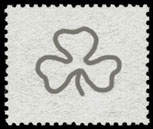
The watermark is shown as seen from the front of the stamp.
Dog license stamps were available in 2s, 10s, and 20s values (for one, five, and ten dogs) and from 1865 to 1882 had a shamrock watermark.
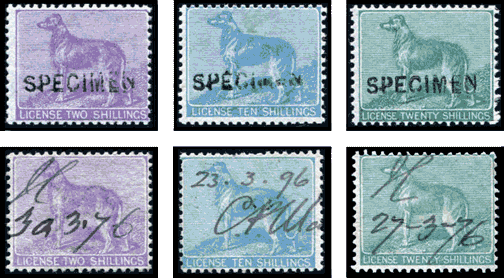
The paper was hand-made, approximately 21″ wide by 11″ high. The watermark had 240 shamrocks, laid out in 12 rows of 20, set within a single line frame. The word “MARK” was above the top left corner, and below the bottom right corner. A small cross was at the centre of each of the four sides.
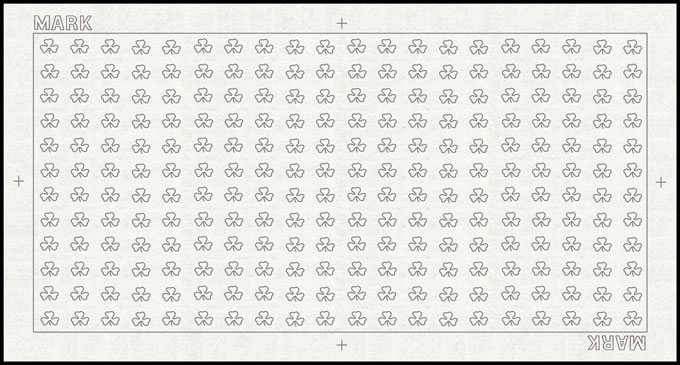
While all other types of paper used for Telegraphs may be considered vertical (portrait, with upright watermarks when viewed vertically), the shamrock paper can be considered horizontal (landscape, with upright watermarks when viewed horizontally).
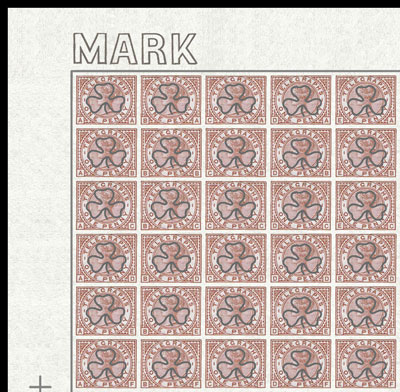
1d. Red-brown (Shamrock).
The shamrocks were arranged so that each 1d stamp (and later each ½d stamp) had one shamrock.
The £1 and £5 stamps of the 1877 issue were also printed on this paper, but this time in a vertical format. The £1 was printed on sheets rotated anticlockwise giving sideways shamrocks, and the £5 was printed on sheets rotated clockwise giving sideways-inverted shamrocks. There is likely no good reason for this difference, just the way the paper was stacked.
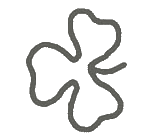
Sideways
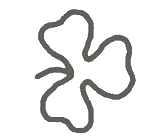
Sideways-inverted
Watermarks shown as seen from the front of the stamp.
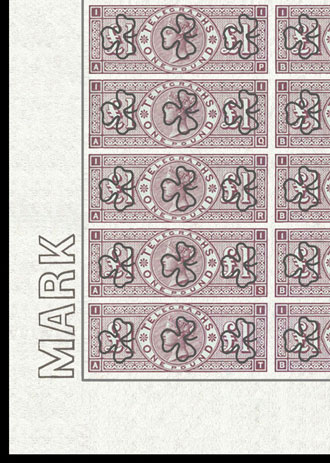
£1 Brown-lilac (Shamrock sideways)
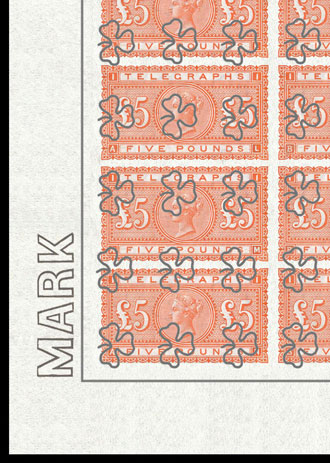
£5 Orange (Shamrock sideways-inverted)
The £1 aligned with the watermark layout, each stamp having three shamrocks. The £5 did not aligned with the watermark layout, occasionally having three, but more often parts of six shamrocks. The colour trials for the £5 and some Specimen Type 9 examples have a sideways watermark.
Spray
Telegraph stamps of the same value as postage stamps were to be printed in the same colour and on the same paper as the corresponding postage stamps. Hence 3d, 6d, and 1s telegraph stamps were printed on Spray of Rose paper. There was no corresponding 3s postage stamp, but as the 3s telegraph stamp was the same size it was also printed on Spray.
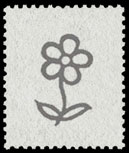
The watermark is shown as seen from the front of the stamp.
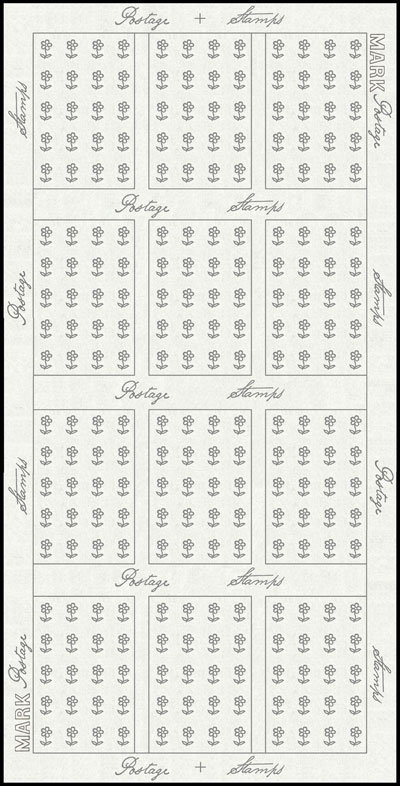
The paper was machine-made, approximately 24″ high by 12″ wide. The watermark had 240 sprays, laid out in 12 panes, arranged as four rows of three. Each pane had 20 sprays in five rows of four, set within a single lined frame. The outside lines of the external frames were connected, so as to surround the group of 12.
The words “Postage Stamps” in script were between each row of panes and in the top, bottom, and side margins. The word “MARK” was at the top of the right margin, and at the bottom of the left margin. A small cross was at the centre of the top and bottom margins.
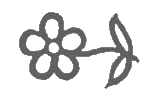
Sideways
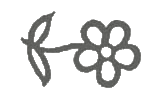
Sideways-inverted
Watermarks shown as seen from the front of the stamp.
The telegraph stamps were in a horizontal or landscape format in order to distinguish them from postage stamps and were therefore printed sideways with reference to the paper. This resulted in a sideways watermark, or infrequently a sideways-inverted watermark if the paper was inverted.
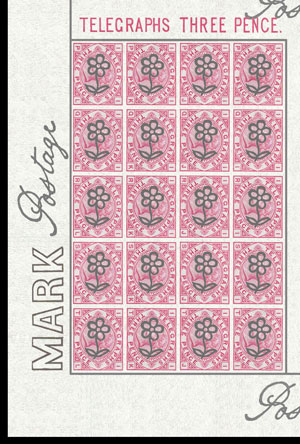
3d. Carmine (Spray sideways)
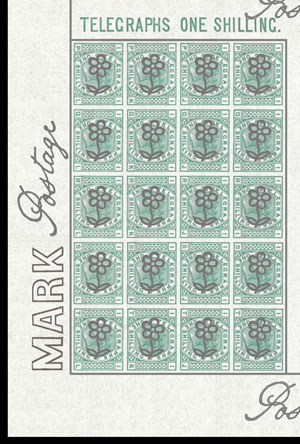
1s. Green (Spray sideways)
Large Garter
The 4d telegraph stamps were also to be printed in the same colour and on the same paper as the corresponding postage stamps. Hence, they were printed on Large Garter paper.
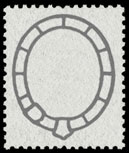
The watermark is shown as seen from the front of the stamp.
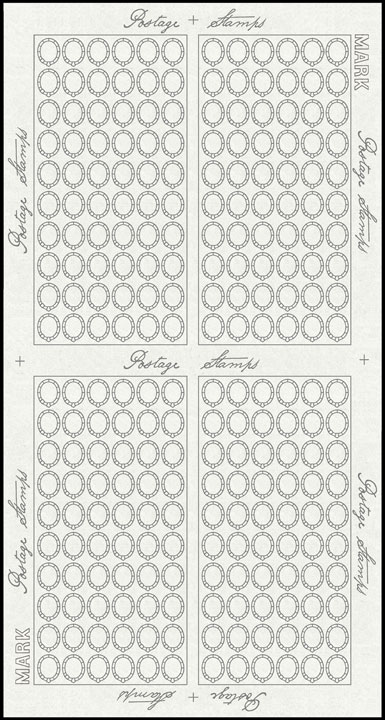
The paper was machine-made, approximately 22″ high by 11″ wide. The watermark had 240 garters, laid out in four panes, arranged two by two. Each pane had 60 garters in ten rows of six, set within a single lined frame.
The words “Postage Stamps” in script were in the top, bottom, and side margins, and in the gap between the upper and lower frames. The word “MARK” was at the top of the right margin, and at the bottom of the left margin. A small cross was at the centre of each of the four sides.
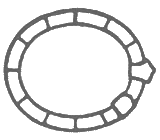
Sideways
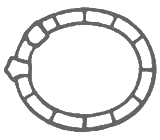
Sideways-inverted
Watermarks shown as seen from the front of the stamp.
The telegraph stamps were in a horizontal or landscape format in order to distinguish them from postage stamps and were therefore printed sideways with reference to the paper. This resulted in a sideways watermark, or infrequently a sideways-inverted watermark if the paper was inverted.
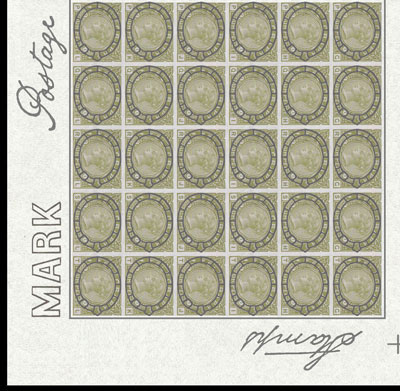
4d. Sage-green (Large Garter sideways)
Crown
In 1880 the Post Office decided to use one kind of paper for most standard sized postage and telegraph stamps. Imperial Crown paper was used upright for postage stamps starting with the 1880 “Provisional” issue, and hence sideways for telegraph stamps. The 3d, 6d, 1s, and 3s plates were altered to fit the new layout, and new telegraph stamps issued in 1881.
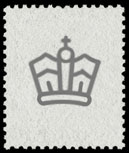
The watermark is shown as seen from the front of the stamp.
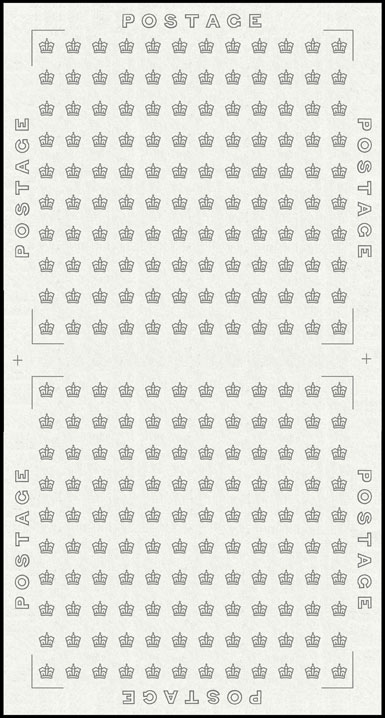
The paper was machine-made, approximately 21″ high by 11″ wide. The watermark had 240 crowns, laid out in two panes, arranged vertically. Each pane had 120 crowns in 10 rows of 12, set within right angle lines at each of the four corners.
The word “POSTAGE” was in the top and bottom margins, and also at each side of each pane. A small cross was at the centre of both sides.
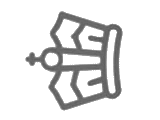
Sideways
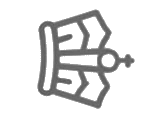
Sideways-inverted
Watermarks shown as seen from the front of the stamp.
The telegraph stamps were in a horizontal or landscape format in order to distinguish them from postage stamps and were therefore printed sideways with reference to the paper. This resulted in a sideways watermark, or infrequently a sideways-inverted watermark if the paper was inverted.
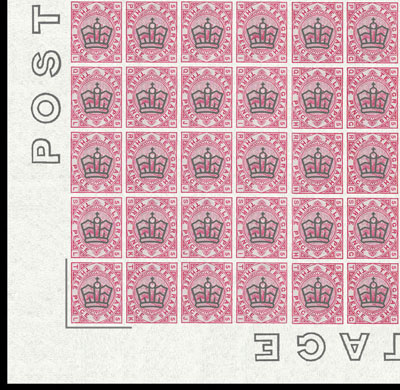
3d. Carmine (Crown sideways)
Maltese Cross
The 5s telegraph stamps were also to be printed in the same colour and on the same paper as the corresponding postage stamps. Hence, they were printed on Maltese Cross (or Croix Paté) paper. There was no corresponding 10s postage stamp, but as the 10s telegraph stamp was the same size it was also printed on Maltese Cross.
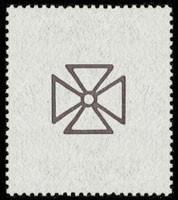
The watermark is shown as seen from the front of the stamp.
The orientation of the cross can be confusing as it looks the same whether viewed from the front, the back, upright, inverted or sideways. However, the sheet has differences, with each pane having four crosses in one direction and five in the other, and the word “MARK” appearing on two of the four sides. The sheet layout below is shown upright, the same as the other paper types are described. In this case, upright is the way the paper was first used with postage stamps.
Wright and Creeke had this confused, describing the sheet oriented as shown for the postage stamps, but then positioning “MARK” in the top of the right margin and the bottom of the left margin. Beaumont and Easton copied this error. “MARK” is above and below the panes for postage stamps, and to the left and right of the panes for telegraph stamps.
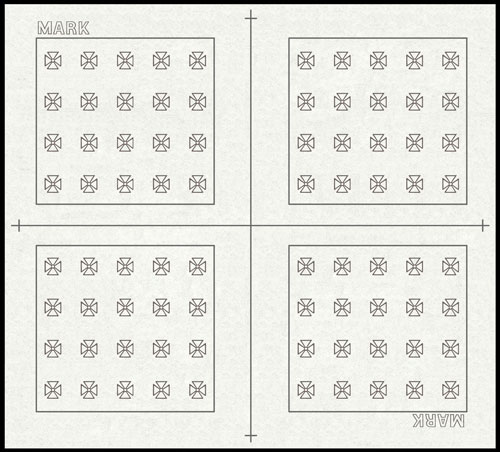
The paper was machine-made, approximately 14″ high by 15″ wide. The watermark had 80 crosses, laid out in four panes, arranged two by two. Each pane had 20 crosses in four rows of five, set within a single lined frame. The panes were separated by a vertical line and a horizontal line which terminated at each end in a small cross.
The word “MARK” was at the left of the top margin, and at the right of the bottom margin.
The telegraph stamps were in a horizontal or landscape format in order to distinguish them from postage stamps and were therefore printed sideways with reference to the paper. This resulted in a sideways watermark, or infrequently a sideways-inverted watermark if the paper was inverted. For the Maltese Cross watermark these cannot be distinguished.
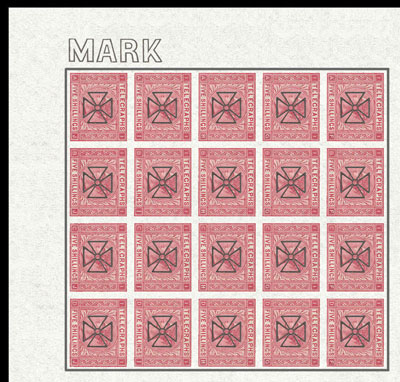
5s. Rose (Maltese Cross)
Large Anchor
In 1881 the Post Office decided to use Large Anchor paper for the 5s telegraph stamp. This paper had been in use for fiscal stamps for many years, and it was now intended to be used for all high value postage and telegraph stamps. Postage stamps were converted over the next few years, but only the 5s telegraph was converted before telegraph stamps were discontinued. The paper was upright for postage stamps and hence sideways for telegraph stamps.
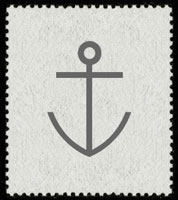
The watermark is shown as seen from the front of the stamp.
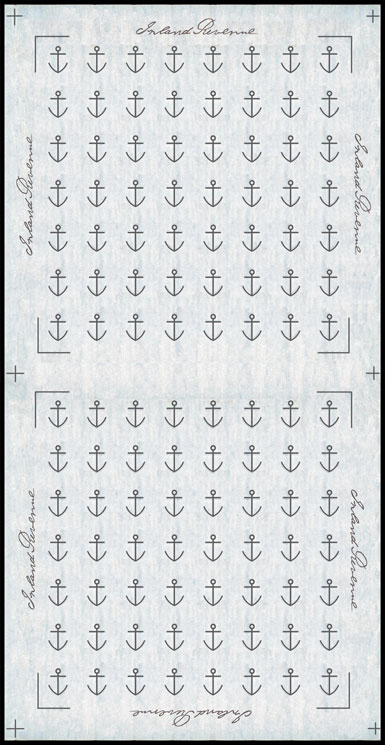
The paper was machine-made, approximately 21″ high by 11″ wide. It was fiscal paper, blued to various degrees by the addition of prussiate of potash. The watermark had 112 anchors, laid out in two panes, arranged vertically. Each pane had 56 anchors in seven rows of eight, set within right angle lines at each of the four corners.
The words “Inland Revenue” in script were in the top, bottom, and side margins. A small cross was at each corner of the sheet, and at the centre of both sides.
The sheet was divided into halves for printing, as the 5s plate was only 56 stamps.
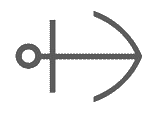
Sideways

Sideways-inverted
Watermarks shown as seen from the front of the stamp.
The telegraph stamps were in a horizontal or landscape format in order to distinguish them from postage stamps and were therefore printed sideways with reference to the paper. This resulted in a sideways watermark, or infrequently a sideways-inverted watermark if the paper was inverted.
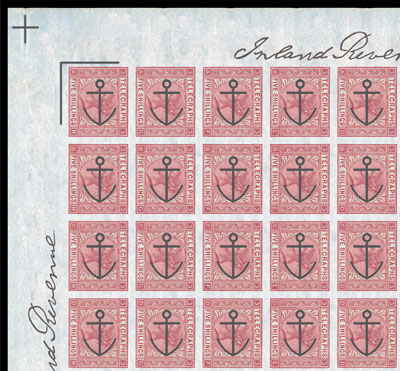
5s. Rose (Large Anchor sideways)
Ink Recipes
It had been decided that telegraph stamps of the same value as postage stamps would be printed in the same colour as the corresponding postage stamps. Hence, most ink recipes are the same as those for the postage stamps.
The two recipes below show the change in colour of the 1s from Green to Italian Brown (Brown-orange) in 1880. The notes in red were added later. The Green recipe says: “This Ink was abandoned for this Postage and Italian Brown Ink used in its place (Recipe 931)”. Further notes were added when the 1s was changed back to green in later years.
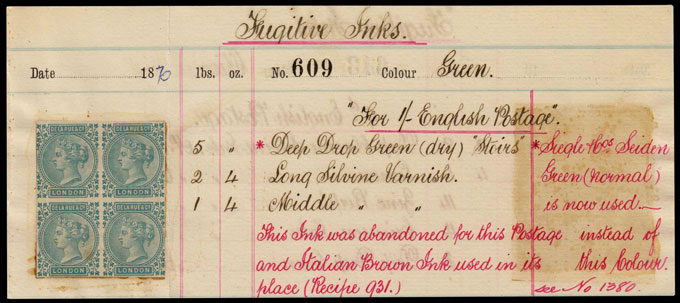
Ink No. 609 — Green
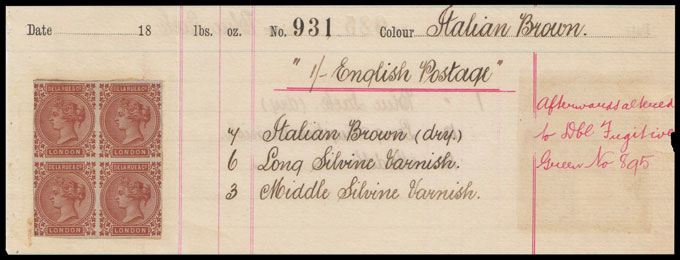
Ink No. 931 — Italian Brown (Brown-orange)
The New Values
The four recipes below are for the new values introduced in 1877. There were no corresponding postage stamps for the 3s, 10s, £1, and £5, so different colours were trialled and these four selected.
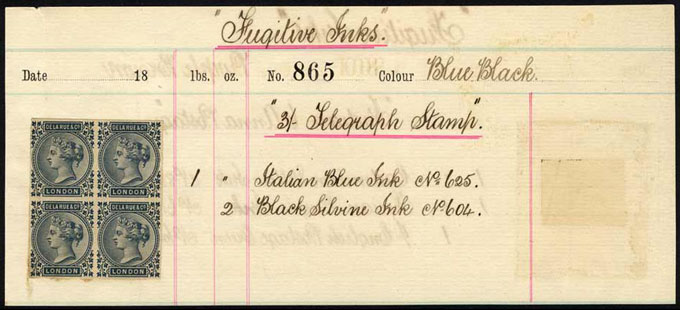
Ink No. 865 — Blue Black (Slate-blue)
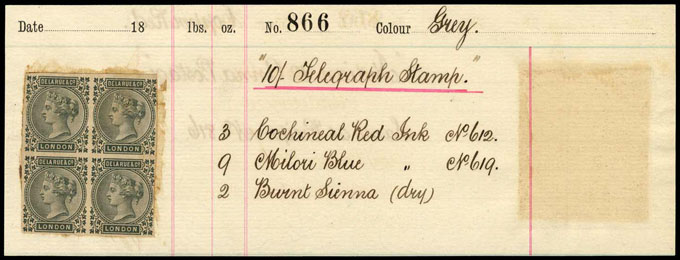
Ink No. 866 — Grey (Grey-green)
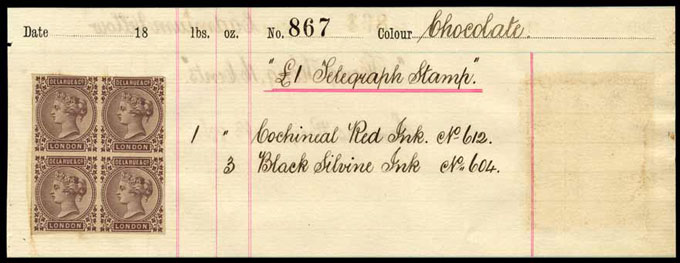
Ink No. 867 — Chocolate (Brown-lilac)
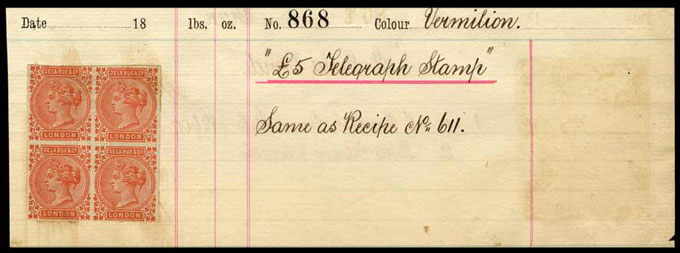
Ink No. 868 — Vermilion (Orange)